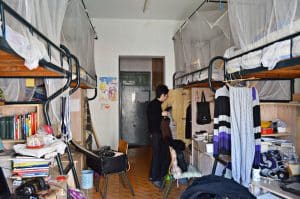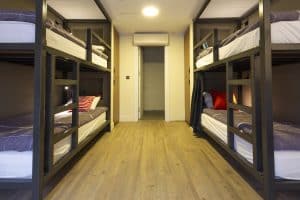Exploring UCLA’s Dorm Room Options
UCLA offers a variety of dorm room options for students looking to live on campus. Understanding the housing system and the different residential halls available can help students make an informed decision about their living arrangements. In this article, we will explore the features of UCLA dorm rooms, discuss the costs associated with dorm living, examine the pros and cons of dorm life at UCLA, and provide tips for choosing the right dorm room.
Understanding UCLA’s Housing System
UCLA’s housing system is designed to provide students with a safe and supportive living environment. The university offers a range of residential halls, each with its own unique features and atmosphere. From traditional dormitories to themed communities, there is something for every student’s preference.
The Process of Room Assignment
Once students receive their admission, they participate in a housing allocation process that involves ranking their roommate preferences and housing choices. It’s worth noting that incoming freshmen typically have the option of selecting triple rooms for their UCLA dorms.
Priority is given to certain groups, including athletes, Regents scholars, and students with disabilities when it comes to housing assignments.
Many students opt to have roommates selected randomly by UCLA. Before making a housing decision, there’s a brief questionnaire with fewer than ten questions. These questions cover topics like your study habits, sleep patterns, and lifestyle preferences, including drinking and smoking habits.
Another avenue for choosing roommates is through social media. Students can join Facebook groups specifically created for recent admissions, where members share photos and brief descriptions of themselves, along with their interests. This approach provides an excellent opportunity to connect with potential roommates and build friendships even before arriving on campus.
In conclusion, UCLA’s housing system offers a diverse range of options to cater to the unique needs and preferences of its students. Whether students are looking for a traditional dorm experience, apartment-style living, or a themed community, UCLA strives to provide a supportive and inclusive environment where students can thrive both academically and socially.
Features of UCLA Dorm Rooms
UCLA dorm rooms are designed to provide students with comfortable and functional living spaces. Each room type has its own layout and amenities, allowing students to choose the option that best suits their needs.
Living in a UCLA dorm room is an exciting and memorable experience for students. The university understands the importance of creating a home away from home, and thus, pays great attention to detail when designing and maintaining these living spaces.
UCLA Campus Housing Options
UCLA offers a range of dormitory options to accommodate student preferences. These options include Classic Halls, Deluxe Halls, Plaza Residences, and Suites.
Classic Halls: These historic buildings, including Dykstra, Rieber, Hedrick, and Sproul, provide a high-rise living experience for students. Each floor offers study lounges and communal facilities with 4-6 shower stalls, toilets, and sinks. Although Classic Halls lack air conditioning, the nearby ocean breeze helps maintain comfortable temperatures. Each UCLA dorm room is equipped with a twin XL bed, desk, dresser, closet, and drawer space.
Deluxe Halls: Similar to traditional structures, Deluxe Halls like Sproul Cove, Sproul Landing, Holly, Gardenia, Olympic, and Centennial feature study lounges and communal bathrooms on each floor. Community laundry rooms are located on the first floor, and large lounges host social events throughout the year. Individual residents have twin XL beds, desks, dressers, closets, and drawers.
Plaza Residences: Campus plaza buildings, including De Neve, Sunset Village, Rieber Terrace, Vista, and Hedrick Summit, offer a variety of room types, including those with private bathrooms and those that share restrooms. De Neve and Sunset Village include courtyards and green spaces between smaller buildings, with communal laundry rooms and study lounges.
Rieber Terrace, Rieber Vista, and Hedrick Summit provide a high-rise experience with study lounges on each floor. All plaza buildings offer social spaces and lounges for student gatherings and events. Each UCLA dorm room includes a twin XL bed, desk, dresser, closet, and drawer space.
Suites: Hitch and Saxon suites are unique at UCLA, featuring smaller buildings and exterior entrances for each apartment. Suites consist of two rooms that share a bathroom and a shared living area. Recent renovations have added more indoor and outdoor social and study spaces. Communal laundry rooms are available at Hitch and Saxon. These buildings benefit from ocean breezes and ample shade from large trees. Each resident has a twin XL bed, desk, dresser, closet, and drawer space, along with living room furniture like couches, chairs, coffee tables, and multifunctional tables.
These diverse UCLA housing options ensure that students can find accommodation that suits their needs and preferences while enjoying a comfortable and engaging living experience on campus.
In conclusion, UCLA dorm rooms offer much more than just a place to sleep. They provide students with a comfortable and functional living space, equipped with essential furnishings and amenities.
The university goes above and beyond to create a vibrant and inclusive community within the dorms, offering various facilities and resources to support student’s personal and academic needs. Living in a UCLA dorm is not just about having a place to stay; it’s about being part of a community and creating lasting memories.
Costs Associated with UCLA Dorm Living
Living in a dorm at UCLA comes with certain costs that students should be aware of when considering their living options. Understanding the breakdown of the UCLA dorm room rates and additional expenses can help students budget accordingly.
When it comes to the cost of living in a UCLA dorm, there are several factors to consider. The type of room and the specific dorm building can affect the overall cost. Room rates typically include utilities, internet access, and residential programming. These amenities are designed to provide students with a comfortable and convenient living experience.
For each academic year spanning nine months, UCLA presents students with various cost considerations based on their living arrangements. These costs include tuition and fees at $13,804, which remain consistent whether students reside in UCLA residence halls, off-campus apartments, or with relatives.
Room and meal expenses differ slightly, with UCLA residence halls costing $17,231, off-campus apartments at $16,224, and living with relatives at $7,101. Additional expenses encompass books and supplies at $1,434, transportation at varying rates depending on the living situation (ranging from $635 to $2,055), personal expenses at $1,494 to $1,848, and health insurance at $2,850, which may be waived if students possess sufficient coverage.
For non-resident students, an additional supplemental tuition fee of $31,026 applies, resulting in a total cost of $68,474 for non-residents and varying totals of $37,448 to $29,092 for California residents, depending on their chosen housing arrangement.
It is important to note that rates are subject to change each academic year. This means that students should stay updated on the latest information regarding dorm room rates. The UCLA Housing website is a valuable resource for students to find the most accurate and current information. Additionally, students can also contact the housing office directly for any specific inquiries they may have.
While the cost of dorm living may seem daunting, it is important for students to explore financial aid options or scholarships that may help offset the expenses. UCLA offers a range of financial assistance programs to support students in their housing needs. By taking advantage of these resources, students can alleviate some of the financial burden associated with dorm living.
Additional Costs to Consider
In addition to room rates, there are other expenses that students should consider when planning for dorm living. One major expense is the cost of a meal plan. UCLA offers a variety of meal plan options to cater to different dietary preferences and needs. These meal plans provide students with access to dining halls and other on-campus food options.
Another expense to consider is the cost of textbooks. Depending on the courses students are taking, the cost of textbooks can add up quickly. It is important for students to budget for these expenses and explore options such as buying used textbooks or renting them to save money.
Personal supplies, such as toiletries and cleaning products, are also additional costs to consider. While some dorms may provide basic supplies, students often need to purchase their own. It is important to factor in these expenses when budgeting for dorm living.
Furthermore, students may want to participate in additional activities or clubs on campus. These extracurricular activities can provide valuable experiences and opportunities for personal growth. However, they may also come with additional costs, such as membership fees or equipment expenses. Students should consider these costs when planning their budget for dorm living.
By taking into account all of these additional costs, students can have a realistic understanding of their financial commitments when living in a UCLA dorm. It is important to plan ahead and budget accordingly to ensure a smooth and enjoyable living experience on campus.
The Pros and Cons of Dorm Life at UCLA
Living in a dorm can have both advantages and disadvantages. Understanding these pros and cons can help students weigh their options and make an informed decision about their living arrangements.
Benefits of Living on Campus
One of the main benefits of dorm life at UCLA is the convenience of living close to campus. Students can easily access their classes, libraries, and other academic resources without the need to commute. Living on campus also provides opportunities for students to connect with their peers and become part of a vibrant community.
Additionally, living in a dorm offers convenience in terms of maintenance and utilities. Students do not have to worry about taking care of repairs or paying separate bills for utilities. This frees up time and energy to focus on their studies and extracurricular activities.
Potential Drawbacks of Dorm Living
While there are many advantages to living in a dorm, there are also potential drawbacks to consider. Some students may find dorm life to be noisy or lacking privacy, especially in shared rooms. Additionally, living in close quarters with other students means adjusting to different schedules, habits, and personalities.
Furthermore, dorm living may not be suitable for students who prefer a more independent lifestyle or who have specific dietary or lifestyle needs that are not easily accommodated in a campus dining hall.
Tips for Choosing the Right Dorm Room at UCLA
Choosing the right dorm room is an important decision that can greatly impact a student’s experience at UCLA. Considering the following factors can help students make a well-informed choice.
Factors to Consider When Selecting a Dorm
When selecting a dorm, students should consider factors such as location, atmosphere, and amenities. Some students may prefer a dorm that is closer to their classes, while others may prioritize a specific community or theme.
It is also important to consider the living arrangements within the dorm, such as room size and layout, as well as the overall cleanliness and condition of the building. Taking a tour or talking to current residents can provide valuable insights into the dorm’s environment.
How to Make the Most of Your Dorm Experience
Once students have chosen their dorm room, there are several ways to make the most of their experience. Getting involved in dorm activities and events can help students connect with their peers and create a sense of community. Students should also take advantage of the resources and support services available through their dorm, such as academic advising or resident assistants.
Additionally, maintaining open communication with roommates can help solve any potential issues and create a harmonious living environment. Establishing boundaries, respecting each other’s space, and practicing good roommate etiquette are essential for a positive dorm experience.
Conclusion
In conclusion, exploring UCLA’s dorm room options is an important step in a student’s journey toward living on campus. By understanding the housing system, considering the features and costs associated with dorm living, and weighing the pros and cons of dorm life, students can make informed decisions about their living arrangements.
Additionally, following the tips for choosing the right dorm room and making the most of the dorm experience can ensure a positive and enriching college life at UCLA.
Having all the necessary information is important before choosing any course of action. AdmissionSight is always here to assist you with any questions or concerns. We have more than ten years of expertise assisting students in successfully navigating the challenging admissions process.
Consult with AdmissionSight and find out what we can do to help you get into the school of your choice by ensuring that you are sufficiently aware and well-prepared for the application process.









































